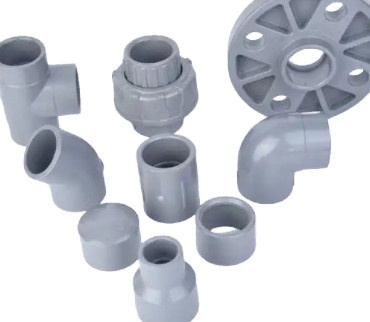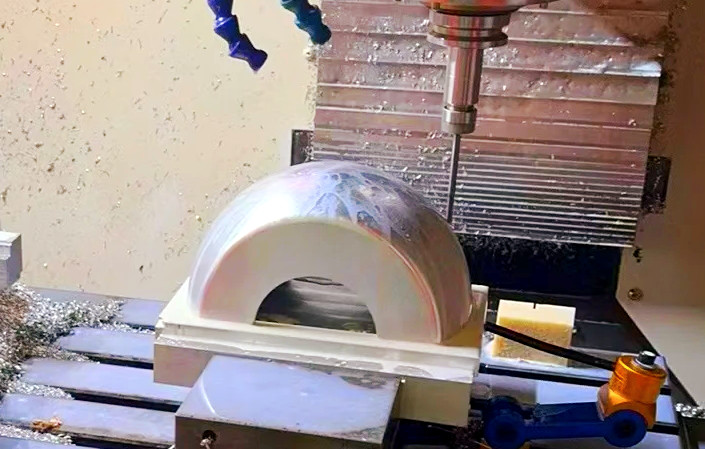Polyvinyl chloride (PVC) is a widely used thermoplastic known for its durability, chemical resistance, and cost-effectiveness. CNC machining of PVC enables the production of precise components for industries such as construction, medical, and electronics. This guide provides a detailed overview of PVC machining, including its types, techniques, specific parameters, and key difficulties, ensuring a technical and systematic approach for professionals seeking to optimize their machining processes.
Understanding PVC as a Machining Material
PVC is a synthetic polymer composed of vinyl chloride monomers, available in two primary forms: rigid (uPVC) and flexible (plasticized PVC). Its properties, such as high tensile strength, chemical resistance, and low moisture absorption, make it suitable for diverse applications. Rigid PVC is commonly used in pipes, window frames, and medical devices, while flexible PVC is employed in electrical insulation and tubing. The table below summarizes the key properties of PVC relevant to machining.
| Property | Rigid PVC (uPVC) | Flexible PVC |
|---|---|---|
| Tensile Strength (MPa) | 40–80 | 15–30 |
| Impact Strength (kJ/m²) | 2–5 | 10–20 |
| Thermal Conductivity (W/m·K) | 0.14–0.17 | 0.12–0.15 |
| Maximum Service Temperature (°C) | 60 | 50 |
| Hardness (Shore D) | 75–85 | 50–70 |
These properties influence machining parameters, as PVC’s relatively low thermal conductivity and heat sensitivity require careful control to prevent deformation or melting. Selecting the appropriate PVC type based on the application is critical for achieving desired machining outcomes.
Types of PVC Machining Processes
CNC machining of PVC involves various subtractive processes, each suited to specific geometries and applications. The following sections detail the primary machining techniques, including their parameters and applications.
CNC Milling
CNC milling uses rotary cutters to remove material from a PVC workpiece, creating flat surfaces, grooves, or complex contours. It is ideal for producing intricate parts with tight tolerances, such as electronic enclosures or medical components.
- Cutting Speed: 100–300 m/min for rigid PVC; 80–200 m/min for flexible PVC.
- Feed Rate: 0.05–0.2 mm/tooth.
- Depth of Cut: 0.5–3 mm for roughing; 0.1–0.5 mm for finishing.
- Tool Material: Carbide or high-speed steel (HSS) with polished flutes to reduce chip adhesion.
- Coolant: Pressurized air or water-soluble coolant to minimize heat buildup.
Milling is versatile but requires stable machine setups to prevent vibrations, which can affect surface quality.
CNC Turning
CNC turning involves rotating the PVC workpiece while a stationary cutting tool shapes it, producing cylindrical parts like pipes or connectors. It is efficient for high-volume production of symmetrical components.
- Cutting Speed: 50–150 m/min for rigid PVC; 40–100 m/min for flexible PVC.
- Feed Rate: 0.05–0.15 mm/rev.
- Depth of Cut: 0.5–2 mm for roughing; 0.1–0.3 mm for finishing.
- Tool Geometry: Positive rake angle (5°–10°) to reduce cutting forces.
- Coolant: High-pressure air or mist to prevent overheating.
Turning requires sharp tools to avoid surface defects caused by PVC’s tendency to form chips that adhere to the tool.
Drilling
Drilling creates precise holes in PVC for fasteners or fluid channels, commonly used in plumbing and automotive applications.
- Cutting Speed: 20–50 m/min.
- Feed Rate: 0.05–0.1 mm/rev for diameters up to 10 mm; 0.1–0.2 mm/rev for larger diameters.
- Drill Geometry: 118°–135° point angle with split-point design to enhance chip evacuation.
- Tool Material: Carbide or cobalt drills for durability.
- Coolant: Air or mist to reduce heat and prevent chip clogging.
Drilling PVC can lead to chip buildup, necessitating frequent tool cleaning to maintain hole accuracy.
Laser Cutting
Laser cutting uses a focused beam to cut or engrave PVC sheets, suitable for intricate designs or decorative panels. It offers high precision and minimal material waste.
- Laser Power: 50–200 W, depending on material thickness (1–10 mm).
- Cutting Speed: 0.5–5 m/min.
- Assist Gas: Compressed air or nitrogen to prevent burning.
- Focal Length: 50–100 mm for optimal beam focus.
Laser cutting PVC requires proper ventilation, as it generates harmful fumes like hydrochloric acid, posing health risks if not managed.
Routing
Routing involves high-speed rotary tools to cut large PVC sheets, often used for signage or functional parts. It is effective for creating complex shapes with clean edges.
- Spindle Speed: 18,000–24,000 RPM.
- Feed Rate: 2–5 m/min.
- Tool Type: Single-flute carbide router bits for smooth cuts.
- Coolant: Air to remove chips and prevent overheating.
Routing is efficient but requires dust collection systems to manage PVC particles generated during the process.
Key Difficulties in PVC Machining
Machining PVC presents several difficulties that impact efficiency and part quality. Addressing these requires precise parameter control and specialized techniques. The following sections outline the primary difficulties encountered.
Heat Sensitivity
PVC has low thermal conductivity (0.14–0.17 W/m·K for rigid PVC), causing heat to accumulate during machining. Excessive heat can lead to melting, deformation, or surface discoloration, particularly at cutting speeds above 300 m/min or depths exceeding 3 mm. To mitigate this:
- Use lower cutting speeds (50–150 m/min for turning, 100–300 m/min for milling).
- Apply coolants like pressurized air or water-soluble mists to dissipate heat.
- Ensure sharp tools to reduce friction and heat generation.
Regular monitoring of tool temperature and workpiece condition is essential to prevent thermal damage.
Chip Management
PVC’s softness and ductility result in stringy or sticky chips that can adhere to tools or clog machining areas, affecting surface finish and tool life. This is particularly problematic in drilling, where chip buildup can cause hole inaccuracies. Solutions include:
- Using polished tools with low-friction coatings to reduce chip adhesion.
- Implementing high-pressure air or coolant to evacuate chips.
- Adjusting feed rates (0.05–0.2 mm/rev for drilling) to produce smaller, manageable chips.
Effective chip management improves machining efficiency and maintains part precision.
Surface Finish Quality
Achieving a smooth surface finish (Ra < 1.6 µm) on PVC is challenging due to its tendency to form micro-scratches or tool marks. Rough finishes often result from improper tool geometry or excessive cutting forces. To enhance surface quality:
- Use carbide tools with positive rake angles (5°–10°) for cleaner cuts.
- Optimize cutting parameters, such as feed rates of 0.05–0.15 mm/tooth for milling.
- Perform finishing passes with shallow depths (0.1–0.3 mm).
Regular tool maintenance and machine calibration are critical for consistent surface finishes.
Material Brittleness
Rigid PVC can be brittle, especially at low temperatures or under excessive clamping forces, leading to cracking or chipping during machining. This is a concern in milling or drilling thin-walled parts. Preventive measures include:
- Reducing clamping pressure to avoid stress concentrations.
- Preheating rigid PVC to 30–40°C to enhance ductility.
- Using low feed rates (0.05–0.1 mm/rev for drilling) to minimize force.
Careful handling and fixturing are necessary to protect PVC workpieces from mechanical damage.
Best Practices for PVC Machining
To achieve optimal results in PVC machining, adhere to the following best practices, which address the material’s unique properties and machining difficulties.
Tool Selection
Choose sharp, polished carbide or HSS tools with positive rake angles to minimize cutting forces and heat generation. For drilling, use split-point drills to enhance chip breaking. Regularly inspect and replace tools to prevent wear-related defects.
Coolant and Ventilation
Use non-aromatic, water-soluble coolants or pressurized air to control heat and remove chips. Ensure proper ventilation, especially during laser cutting, to manage harmful fumes. Dust extraction systems are recommended for routing and milling to maintain a clean workspace.
Machine Calibration
Regularly calibrate CNC machines to maintain accuracy, particularly for tight tolerances (±0.01 mm). Stable setups with minimal vibrations are essential for high-precision milling and turning.
Quality Control
Implement rigorous inspection protocols using coordinate measuring machines (CMM) or laser scanners to verify tolerances and surface quality. Post-machining cleaning removes chips and dust, ensuring parts meet specifications.
Applications of Machined PVC Parts
Machined PVC components are integral to multiple industries due to their versatility and performance. Common applications include:
- Construction: Pipes, fittings, and window frames made from rigid PVC for durability and corrosion resistance.
- Medical: Tubing, containers, and device housings leveraging PVC’s biocompatibility and chemical resistance.
- Electronics: Insulation components and enclosures utilizing PVC’s dielectric strength.
- Automotive: Interior trim and fluid channels benefiting from PVC’s lightweight and impact resistance.
These applications highlight PVC’s adaptability when machined with precision and care.

Conclusion
PVC machining is a reliable and cost-effective process for producing high-quality components across various industries. By understanding PVC’s properties, selecting appropriate machining techniques, and addressing difficulties like heat sensitivity and chip management, manufacturers can achieve precise and consistent results. Adhering to best practices, such as proper tool selection, coolant use, and quality control, ensures optimal performance and part integrity. This guide serves as a technical resource for professionals aiming to master PVC machining processes.
